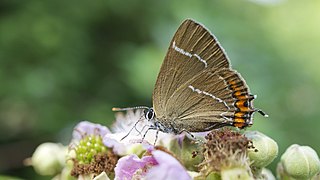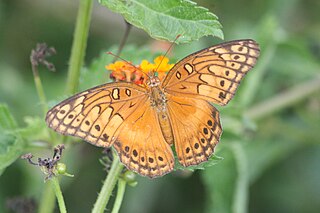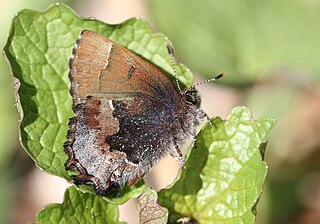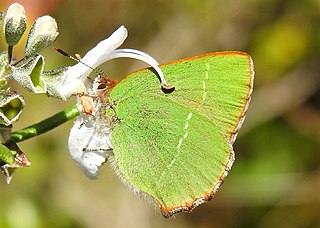
The green hairstreak is a small butterfly in the family Lycaenidae.

The white-letter hairstreak is a butterfly in the family Lycaenidae.

The black hairstreak is a butterfly in the family Lycaenidae.

The genus Callophrys consists of butterflies in the family Lycaenidae. It is apparently not monophyletic, but which of the taxa currently considered junior synonyms of Callophrys are valid genera remains to be determined.

The Sandia hairstreak is a species of butterfly native to North America. A relatively rare butterfly with a limited range, it was discovered in La Cueva Canyon, Albuquerque, in spring of 1958, by Noel McFarland, then a student at the University of Kansas, and described the following year. The Sandia hairstreak was made one of the state insects of New Mexico in a 2002 bill approved the following year.

Euptoieta claudia, the variegated fritillary, is a North and South American butterfly in the family Nymphalidae. Even though the variegated fritillary has some very different characteristics from the Speyeria fritillaries, it is still closely related to them. Some of the differences are: variegated fritillaries have two or three broods per year vs. one per year in Speyeria; they are nomadic vs. sedentary; and they use a wide range of host plants vs. just violets. And because of their use of passionflowers as a host plant, variegated fritillaries also have taxonomic links to the heliconians. Their flight is low and swift, but even when resting or nectaring, this species is extremely difficult to approach, and, because of this, its genus name was taken from the Greek word euptoietos meaning "easily scared".

Euptoieta hegesia, the Mexican fritillary, is a North and South American butterfly in the family Nymphalidae.

Callophrys henrici, the Henry's elfin or woodland elfin, is a North American butterfly in the family Lycaenidae. In Canada it is found from southern Manitoba to southern Nova Scotia. It has two main groups of populations in the United States; the first is found along the Atlantic Coast and uses various hollies (Ilex) as host plants; and the second is found mainly in the north and the Appalachians where they use redbud as a host plant. Henry's elfin is increasing in New England because of an introduced buckthorn it now uses as a host plant. It is listed as a species of special concern in the US state of Connecticut.

Chlorostrymon simaethis, the silver-banded hairstreak, is a North and South American butterfly in the family Lycaenidae. It is also known as St. Christopher's hairstreak and the Key lime hairstreak.

Callophrys sheridanii, the Sheridan's hairstreak and Sheridan's green hairstreak, is a butterfly in the family Lycaenidae. It is found in North America along the south coast of British Columbia and parts of Nevada, Arizona, Saskatchewan, North Dakota, and New Mexico. In 2009, this species was adopted as the U.S. state butterfly for Wyoming.

Callophrys spinetorum, the thicket hairstreak, is a butterfly of the family Lycaenidae. It was described by William Chapman Hewitson in 1867. It is found in North America from British Columbia through the Rocky Mountains to New Mexico and Mexico and through California to Baja California. The habitat consists of pinyon-juniper forests, mixed woodlands, and coniferous forests.

Callophrys xami, commonly referred to as the xami hairstreak or green hairstreak, is a butterfly included in the subgenus Xamia and the genus Callophrys in the family Lycaenidae. It was described by Tryon Reakirt in 1867. Other common names for this species, depending on the region, include green hairstreak and elfin. C. xami is considered to be a very rare species of butterfly, and its typical range is in southern Arizona and Texas including down south to Guatemala. The juniper hairstreak and the silver-banded hairstreak butterflies are similar species, but both differ significantly from C. xami in regards to the postmedian white line running across the butterfly wings.

Callophrys avis, the Chapman's green hairstreak is a small butterfly found in the Palearctic that belongs to the blues family. The males and females of this little butterfly are identical. The underside of the wings is green, the upperside is greyish brown. The green verso is marked by a mediodiscal white line that differentiates this species from Callophrys rubi. The larva feeds on Coriaria myrtifolia, Arbutus unedo, Salvia verbenaca, Viburnum tinus.
















